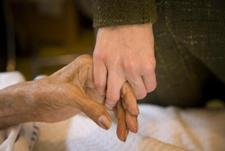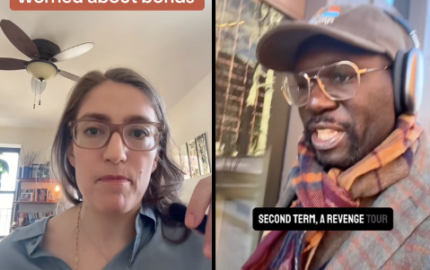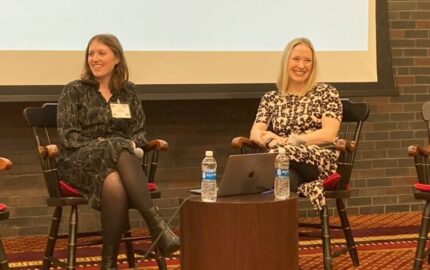 Storyboard recently talked about visual storytelling and intimacy with two very different journalists: an independent 30-year veteran and a newsroom staff photographer just two years out of graduate school.
Storyboard recently talked about visual storytelling and intimacy with two very different journalists: an independent 30-year veteran and a newsroom staff photographer just two years out of graduate school.Yesterday, we learned how Dallas Morning News reporter and relative newcomer Sonya Hebert immersed herself in the world of end-of-life care and came back with powerful stories. Today, we hear what it was like for a seasoned pro to turn a camera on his own family in the midst of crisis.
Ed Kashi has reported from all over the globe, capturing images of everything from war to Warhol. But when Kashi and his wife, Julie Winokur, moved their family across the country to help her ailing father, the years of multimedia that they had done on aging didn’t fully prepare them for becoming caregivers. Given the opportunity to do a project on the "sandwich generation"—adults caring for both their own children and their aging parents—they decided to turn the cameras on themselves.
Was The Sandwich Generation the first time you reported on your own life?
The first time, and the only time—unless you count part two, Living with Herbie. My thing is not to do that. I’m not into navel gazing—which is unfortunate, because that’s probably the hottest thing in the art world.
The week my wife’s father, Herbie, moved in with us was the week Brian Storm called about this MSNBC project on adults taking care of both their kids and their parents. There was no way we could go out and do the reporting and figure out how to handle her father moving in at the same time. So I realized we could either focus the project on ourselves, or we could pass on it. I thought we should give it a shot. Julie said, “Fine, but you’re going to have to do everything.”
Who shot the footage?
Julie didn’t do anything. Her priorities were straight. Her priority was her dad. Obviously, she saw the merit and the importance of us doing it, or she would have said no.
My eight- or nine-year-old daughter has a photo credit. It was very democratic. I did 90 percent or more of the camera work. I put cameras on two floors to be prepared to capture any moment, because so much of it is process. What does it look like when we bathe him? When we shave him? But often someone else would pick up a camera and record a moment, too.
What was it like to merge the personal and the professional?
It forced me to have a bit of objectivity, if you like. It was actually therapeutic. I was very involved in his caregiving while doing this documentary. Sometimes I’d put the camera in the room and hit the “wide” button. It was an interesting hybrid experiment. Having a little bit of that objectivity allowed me to keep perspective on the situation. It’s easy to get emotionally lost.
A year later, the second time around, when we did Living with Herbie, I was thoroughly annoyed I had to do it. That time, Julie did take part. I had just come back from a long trip to India and I really didn’t want my house to be the field at that time. I was a little resentful of him—I wanted to relax. But I couldn’t just sit in the house—I had to think, “This is an important moment. I better get it.”
How did you consider the idea of privacy and consent when your father-in-law had dementia?
I hate model releases. I do them domestically, but I’m a real believer in the unspoken permission that subjects give me. In the case of Herbie, he was completely aware of what we were doing. It’s a reflection of who he was that he’s a very sweet man and a very trusting man. If this were something that his daughter and I were doing that he didn’t want done, he would have let us know.
Did you have ground rules for what you would shoot and what you wouldn’t?
I’m pretty unflinching in that sense, within reason. Nothing is off limits, though I maintain standards of decency and respect—standards I would keep with anyone.
Were there things too intimate to use?
The times we had him in his underpants—I never flinch from things like that, unless the subject has a problem with it.
I’m a real believer that in this work you gain the subjects' permission through trust and confidence. You can build that in 30 seconds or in a year. Quite frankly I feel that it’s a real strength that I have in doing this work. People trust me, and they feel comfortable. Not all the time, but I’ve learned how to hone that skill. It’s who I am.
I can’t wait to meet you. I guarantee you that I’ll ask you all kinds of questions. I’m genuinely interested. I don’t do it in a manipulative way. Most people like to talk about themselves—not everybody, but most people.
When we were doing our aging work, we were performing a function by being a companion to these elderly folks. Here we were, relatively young people asking them questions about themselves.
That’s a big part of storytelling—to open people up by giving them an opportunity to share themselves with others. It’s human nature to want to. What’s tough is when you have to do stuff with people who are closed or suspicious. Sometimes with political work or conflict areas, it’s more difficult.
How did you think of the story while you were getting footage together?
In terms of structure, during the period we were still doing documentation, Herbie fell, and had to go to the hospital. That was something we couldn’t anticipate. But for the purpose of the story, it added a dramatic narrative arc.
Did you have anyone other than your wife, Julie Winokur, help decide on the story and how to build it? Did you ever feel you were too bound up subjectively to know where to go next?
I’m the coal miner, and she’s the diamond polisher. She is an amazing editor—and now, multimedia producer. I’m the field person. In that sense, this suited our talents. Julie’s also a fine reporter. In this particular case, I did most of the documentation, and Julie put it together.
On the first part, she worked with Brian Storm. Typically when they work together, Julie will take it 70 to 90 percent of the way, and then Brian will come in and do a top edit. He’s particularly good at that—figuring out what will flesh out the visual narrative. Julie is really strong at creating narrative through words and sound bites. It was challenging to work on this, but I also think it was cathartic as well.
If it was cathartic personally, how was it professionally?
On the level of form, if you like, the structural level, it was a breakthrough on integrating video and stills. We started to see where a still moment could be completed in a video moment. I know a couple people have written college theses on that aspect of the piece.
I think on some level it would have happened no matter what the subject had been. This multimedia thing is basically doing short documentary. But at the point we were at in 2006, where we had been doing video and stills for about five years but were becoming more conscious of our own creative evolution as separate from what anyone else was up to—at that point, we were making breakthroughs in making use of video and stills. The fact that what we were doing most of it in our home and we didn’t have to chase after it maybe allowed us to do more exploration than we might have otherwise.
Not to return to navel gazing, but did you learn anything about yourself?
Earlier in my career I was much less patient. By becoming more patient over time, I’ve learned to see more deeply.
Ten to 15 years ago, I wouldn’t have had the patience to do something relatively sedentary. Now, as a human being, I like to believe I’ve learned more about myself, human nature and the world. Even in my foreign work, I’m able to pick up on more things now.
Where I might have looked 15 years ago and seen nothing, now I see there’s meaning. The picture I’m making has more meaning to me. Then it’s like, “Aha!” I’ve made a picture that has a dynamic.
But even when I was 12 or 13 years old at the train station or the Port Authority, I would stare at people until they would snap at me. This is just part of my DNA. I’m a professional busybody. I get absorbed in watching the world.


